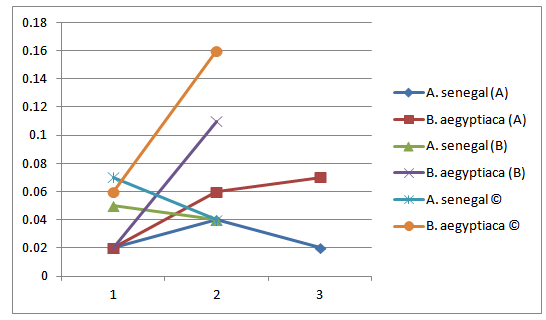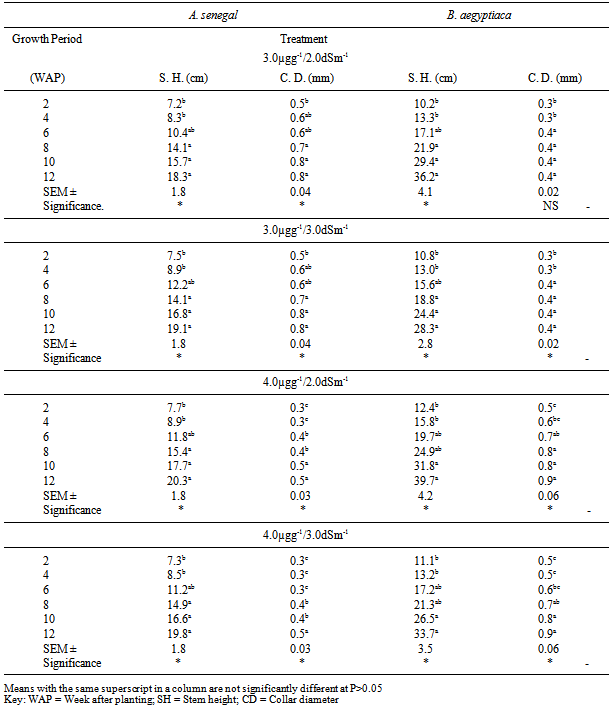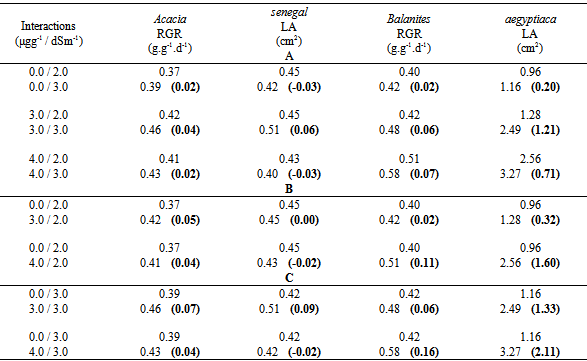-
Paper Information
- Next Paper
- Previous Paper
- Paper Submission
-
Journal Information
- About This Journal
- Editorial Board
- Current Issue
- Archive
- Author Guidelines
- Contact Us
International Journal of Agriculture and Forestry
p-ISSN: 2165-882X e-ISSN: 2165-8846
2014; 4(2): 62-66
doi:10.5923/j.ijaf.20140402.02
Interaction of IAA and NaCl on the Early Growth of Acacia senegal (L.) Willd and Balanites aegyptiaca (Linn) Del. in Semi-arid Area of Sokoto, Nigeria
Igbokwe G. O.1, A. G. Bello1, A. D. Isah1, M. Audu2
1Department of Forestry and Fisheries, Usmanu Danfodiyo University, Sokoto
2Department of Soil Science and Agricultural Engineering, Usmanu Danfodiyo University, Sokoto
Correspondence to: Igbokwe G. O., Department of Forestry and Fisheries, Usmanu Danfodiyo University, Sokoto.
| Email: |  |
Copyright © 2012 Scientific & Academic Publishing. All Rights Reserved.
Acacia senegal and Balanites aegyptiaca are two important forest tree species adaptable to the semi-arid region of Sokoto, Nigeria. This experiment was conducted to determine the interaction response of these species to hormone (Indole-3-acetic acid IAA) and Salt (NaCl). Soil from two sites containing the salt level (2.0 and 3.0dS/m) in Dabagi research farm of Usmanu Danfodiyo University, Sokoto were used to grow the plants while hormone was introduced both at germination and early growth stages. Result showed that interaction effect increased leaf and relative growth rates in both plants. This technique could be used in the development and establishment of these tree species in semi-arid region.
Keywords: Salinity, Indole-3-acetic acid, Interaction, Growth
Cite this paper: Igbokwe G. O., A. G. Bello, A. D. Isah, M. Audu, Interaction of IAA and NaCl on the Early Growth of Acacia senegal (L.) Willd and Balanites aegyptiaca (Linn) Del. in Semi-arid Area of Sokoto, Nigeria, International Journal of Agriculture and Forestry, Vol. 4 No. 2, 2014, pp. 62-66. doi: 10.5923/j.ijaf.20140402.02.
Article Outline
1. Introduction
- Soil salinity has been defined as a soil condition characterized by a high concentration of soluble salts. Many factors such as humidity, temperature, light, irrigation, and soil fertility interact to create salinity [1]. These also complicate studies on the effects of salinity on plants. Sodium (Na) may be utilized by some plants as a partial substitute for potassium (K), it is not an essential plant nutrient and when present in the soil in significant quantities can have adverse effect both on crop growth and soil physical conditions. Salty soils are generally unsuitable for crop growth. As a result of population growth and land demand, forest tree growers have identified the need to look at and make use of these unsuitable lands for tree growth objectively to improve cultivation practices and to feed the growing population. Acacia senegal (L.) Willd and Balanites aegyptiaca (Linn.) Del. are two important tree species found in the semi-arid region of Sokoto state Nigeria. Acacia senegal commonly known as gum Arabic is grown in agro-forestry systems especially for its economic important liquid exudates (gum arabic) of which over 70% of world production is used in the food industry and medicine [2]. B. aegyptiaca popularly called Aduwa (Hausa) for food, fodder and medicinal values [3]. According to [4] 68% of the total land area in the state has been identified and classified as marginal in accordance with FAO [6] modified land capability classification. It was also reported these lands as unsuitable for arable cropping but suitable for forestry, water-shed protection and recreation [4]. Many scientists have become discouraged by the fact that salt tolerance remains largely unexplained due to the many physiological processes that are affected by the stress. This presents difficulties when transgenic genes are inserted into plants, and the results are not apparent. As they learn more about the cellular mechanisms and what pathways are explored, then it will be easier to use genetic modification. Most likely the modification will have to tackle multiple aspects of the salt sensitivity and will assist crop growing, but not to formulate plants that can grow in abnormally high concentrations of salt [5]. The aim of this research is to examine the interaction of Indole-3-acetic acid and sodium chloride on the performance of these important indigenous trees.
2. Materials and Method
2.1. The Study Area
- The study area was Sokoto in the northern western part of Nigeria. It lies within latitude 13-14°N and longitudes 5°30’E and 6°’E. The area is of interest because its environment is characterized by high range of temperature of about 15-40℃, low relative humidity, mostly constant winds, dust, sand storms and erosion which sometimes lead to destruction of man-made structures and displacement of human settlement, small quantity of seasonal rainfall of 600mm in three month duration, which aggravate the conditions prevalent in salinity prone soils.
3. Methodology
- Soil samples were collected from two areas within Dabagi research farm. The soil samples were bulked and tested to determine salinity levels using the OSK soil test kit. Seeds of A. senegal and B. aegyptiaca were collected from mother trees grown within Usmanu Danfodiyo University, Sokoto. The soil samples were used for germination and out growth of Balanites aegyptiaca and Acacia senegal. Two concentrations (3.0µgg-1 and 4.0µgg-1) of the plant growth hormones (indole-3-acetic acid) were administered both at sowing and fortnightly during growth stages to determine any alteration in growth parameters. This research was conducted as a factorial experiment in a completely randomized block design with five replications. The main factor was the hormone (Indole-3-acetic acid) and sub-factor was the salinity. Natural saline soils with electrical conductivity of 2.0 and 3.0dS/m was used to germinate and raise the seedlings, while saline water with 4dS/m was applied to maintain the salinity levels.
4. Results and Discussion
- The result of stem height and collar diameter obtained fortnightly is shown in Table 1. Measurement of mean leaf area and calculation of relative growth rates (RGR) obtained from fresh and dry weight of the vegetative parts at the end of the experimental period (12 weeks) are as shown in Table 2. The stem height and collar diameter of the trees responded positively to treatments of hormone applied since there significant differences between the first and last week of readings obtained. However, there were no significant differences in stem growth observed between 10 and 12 weeks after planting for all treatments. There were direct relationship between leaf area and relative growth rates in all the groups, this is an indication that the photosynthetic surface of a plant plays a significant role in organic matter formation and storage. It was observed that an increase in hormone (IAA) at the same salt level resulted to an increase in RGR for B. aegyptiaca but a decrease in RGR for A. senegal (Table 2 and Figure 1).
|
|
 | Figure 1. Graph of Growth Difference Between Interactions Compared |
5. Discussion
- Stem height, collar diameter and mean leaf area growth of B. aegyptiaca were greater at the end of planting period compared with A. senegal (Table 1), this is possibly due to the genetic makeup of the species [5]. The interactions between hormone (IAA) and salt (NaCl) were compared using fresh and dry weight of A. senegal and B. aegyptiaca to determine relative growth rates (RGR) in Table 2. There were some variations observed in RGR of the two species at different hormone and salt interactions. Increasing salinity and hormone interaction led to significant increase in leaf area and RGR in B. aegyptiaca and a decrease leaf area and RGR in A. senegal (Table 2). Results obtained at 0.0μgg-1/ dSm-1 showed that there were no difference between RGR in A. senegal and B. aegyptiaca. However, the addition of (3.0μgg-1) IAA resulted in increased plant growth in the two species with B. aegyptiaca showing greater RGR. Further increasing IAA to 4.0μgg-1 resulted in decreased RGR in A. senegal but an increased RGR in B aegyptiaca. The above trends were also observed in LA growth. Salt stress an off-shoot of drought has a higher negative effect on the growth of A. senegal than observed in B. aegyptiaca. Results obtained under 3.0μgg-1 / 3.0dSm-1 treatment for A. senegal were better compared with other interactions tested. This agreed with the findings of [6] who in their work with A. senegal and B. aegyptiaca reported that Indole-3-acitic increased germination and early growth of the species. It was observed that a higher hormonal input was required to induce an increase growth and leaf area as shown in A. senegal at 4.0μgg-1/3.0dSm-1 (0.43g.g-1.d-1 and 0.52cm2) and B. aegyptiaca 3.0μgg-1 / 3.0dSm-1 (0.58g.g-1.d-1 and 3.27cm2). The large LA and water content observed in the fresh weight could be a mechanism developed by the plants to mitigate salt stress [7]. Studies by some authors showed that the response of plants varies by the extent to which they are exposed to salinity [8]. Large LA could result in greater exposure of leaf surface to photosynthetic activities thereby leading to increased biomass production and storage. This agrees with [9] who reported that NaCl treatment greatly increased Mg uptake rates and increased the rates of net photosynthesis and biomass production of stems and roots in Pinus radiata. Increase in leaf area and hence relative growth rate pomegranate cultivars was attributed to the hormone Indole-3-acetic acid [10] [11], they also revealed that increase in salinity levels by up to 4 dSm-1 level could increased vegetative growth but exceeding this level may lead to decline in vegetative growth. Salinity tolerant plants are more capable of surviving and maintaining their growth rate under salinity stress conditions as revealed by Balanites aegyptiaca in this study. Growth difference can be regarded as an efficient index of salinity tolerance [13].
6. Conclusions
- Acacia senegal and Balanites aegyptiaca are both important trees found in the semi-arid region of Sokoto, Nigeria. They grow under the same climates and face similar environmental stress such as drought and salts. This work studies the physiological and environmental performance of these species under salt (NaCl) using indole-3-acetic acid to ameliorate this stress. It was discovered that the germination and seedling growth of B. aegyptiaca performed better than A. senegal and have higher tolerance to medium through high salinities and could be recommendable for plantation establishment and reclamation of soils in semi-arid regions with medium through high salinity levels. To promote the development and establishment of the important indigenous tree species in semi-arid and of course in Africa south of the Sahara, the interaction effects of hormone and salt stood as a very good alternative. The species developed using this technique can also be incorporated into land reclamation projects for the promise this research has indicated. This can also influence the decision of tree growers on the choice of hitherto neglected species like B. aegyptiaca for plantation establishment.
ACKNOWLEDGEMENTS
- We wish to acknowledge the Department of Forestry and Fisheries, Usmanu Danfodiyo University, Sokoto for providing the enabling environment and material support for this work.
 Abstract
Abstract Reference
Reference Full-Text PDF
Full-Text PDF Full-text HTML
Full-text HTML
